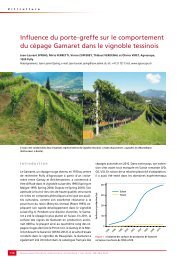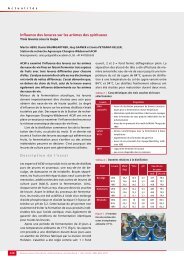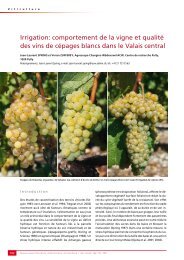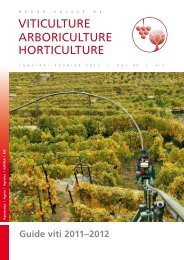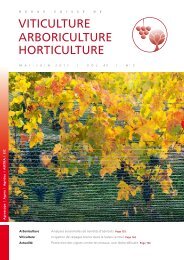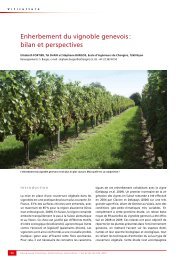Télécharger le PDF - Revue suisse de viticulture arboriculture ...
Télécharger le PDF - Revue suisse de viticulture arboriculture ...
Télécharger le PDF - Revue suisse de viticulture arboriculture ...
You also want an ePaper? Increase the reach of your titles
YUMPU automatically turns print PDFs into web optimized ePapers that Google loves.
Influence <strong>de</strong>s techniques d’éclaircissage sur <strong>le</strong> ren<strong>de</strong>ment, la morphologie <strong>de</strong>s grappes et la sensibilité à la pourriture du cépage Gamay | Viticulture<br />
– compacité <strong>de</strong>s grappes peu avant la vendange<br />
(échel<strong>le</strong> <strong>de</strong> 1 = absence <strong>de</strong> contact entre <strong>le</strong>s baies<br />
à 9 = grappe extrêmement compacte);<br />
– intensité <strong>de</strong> la coulure et du mil<strong>le</strong>randage (échel<strong>le</strong><br />
<strong>de</strong> 0 = absence <strong>de</strong> coulure et <strong>de</strong> mil<strong>le</strong>randage<br />
à 9 = grappe tota<strong>le</strong>ment coulée ou mil<strong>le</strong>randée).<br />
• Pourriture grise (B. cinerea)<br />
– pourcentage <strong>de</strong> grappes atteintes et intensité<br />
<strong>de</strong> l’infection (estimation <strong>de</strong> la part <strong>de</strong>s grappes<br />
infectées 0, 1/10, 1/4, 1/2, 3/4, 4/4). Observation<br />
<strong>de</strong> 4 x 50 grappes par variante au moment <strong>de</strong>s<br />
vendanges.<br />
• Vigueur<br />
– contrô<strong>le</strong> <strong>de</strong> l’expression végétative par <strong>le</strong> pesage<br />
<strong>de</strong>s bois <strong>de</strong> tail<strong>le</strong>.<br />
• Analyses <strong>de</strong>s moûts<br />
– teneur en sucre, pH, acidité tota<strong>le</strong> (exprimée en<br />
aci<strong>de</strong> tartrique), aci<strong>de</strong> tartrique, aci<strong>de</strong> malique et<br />
teneur en azote <strong>de</strong>s moûts par l’indice <strong>de</strong> formol<br />
(Aerny 1996).<br />
Résultats<br />
Morphologie <strong>de</strong>s grappes<br />
L’application <strong>de</strong> gibbérelline et <strong>de</strong> prohexadionecalcium<br />
a eu une influence importante sur l’intensité <strong>de</strong> la<br />
coulure et du mil<strong>le</strong>randage, ainsi que sur la compacité<br />
<strong>de</strong>s grappes (fig.1 et 2). Si la gibbérelline a surtout<br />
causé l’avortement d’une partie <strong>de</strong>s baies (fig.1D et E),<br />
Note (0 / 1–9)<br />
9<br />
8<br />
7<br />
6<br />
5<br />
4<br />
3<br />
2<br />
1<br />
0<br />
a<br />
Témoin non dégrappé (A)<br />
c<br />
a<br />
1 grappe/bois (B)<br />
c<br />
2 <strong>de</strong>mi-grappes/bois (C)<br />
bc bc<br />
c<br />
25 ppm GA 3 (D)<br />
Compacité <strong>de</strong>s grappes (note 1–9)<br />
Coulure/mil<strong>le</strong>randage (note 0–9)<br />
b<br />
c<br />
50 ppm GA 3 (E)<br />
Figure 2 | Essai <strong>de</strong> limitation <strong>de</strong> la récolte sur Gamay.<br />
ab<br />
ab<br />
Regalis 1,65 kg/ha (F)<br />
Notations <strong>de</strong> la compacité <strong>de</strong>s grappes (note <strong>de</strong> 1 à 9), <strong>de</strong> la coulure<br />
et du mil<strong>le</strong>randage (note <strong>de</strong> 0 à 9).<br />
Leytron (VS), moyennes 2008–2010 (<strong>le</strong>s variantes signalées par une <strong>le</strong>ttre<br />
commune ne se distinguent pas significativement, p = 0,05).<br />
a<br />
la prohexadionecalcium a surtout entraîné la production<br />
d’une certaine proportion <strong>de</strong> baies mil<strong>le</strong>randées<br />
(fig.1F). Pour <strong>le</strong>s applications <strong>de</strong> GA 3 , l’effet a été proche<br />
pour <strong>le</strong>s <strong>de</strong>ux doses considérées. La section <strong>de</strong>s<br />
grappes par la moitié (fig.1C) a fourni <strong>de</strong>s raisins nettement<br />
moins volumineux, susceptib<strong>le</strong>s <strong>de</strong> se ressuyer<br />
plus rapi<strong>de</strong>ment après <strong>de</strong> fortes précipitations et<br />
d’échapper à l’éclatement par compression souvent<br />
observé dans <strong>le</strong>s grosses grappes compactes du Gamay.<br />
Ces résultats sont largement confirmés par d’autres<br />
travaux sur du Pinot noir (Siegfried et Jüstrich 2008; Hill<br />
et al. 2003; Spring et Viret 2009) mais éga<strong>le</strong>ment sur<br />
beaucoup d’autres cépages (Mehofer et al. 2008; Weaver<br />
et Pool 1971; Bottura et al. 2003; Haas et al. 2009;<br />
Schildberger et al. 2011; Böll et al. 2009a).<br />
Métho<strong>de</strong>s d’éclaircissage et composantes<br />
du ren<strong>de</strong>ment<br />
Sur <strong>le</strong> Gamay, <strong>le</strong>s applications <strong>de</strong> gibbérelline ont fortement<br />
influencé la fertilité <strong>de</strong>s bourgeons pour l’année<br />
suivant l’application (arrièreeffet) (fig. 3). Dans <strong>le</strong>s<br />
variantes dégrappées manuel<strong>le</strong>ment et la variante<br />
avec prohexadionecalcium, la fertilité <strong>de</strong>s bourgeons<br />
est restée é<strong>le</strong>vée, au<strong>de</strong>ssus d‘une grappe et <strong>de</strong>mie par<br />
bois. Les applications <strong>de</strong> gibbérelline ont provoqué,<br />
dès l’année suivant la première application, un effondrement<br />
<strong>de</strong> la fertilité <strong>de</strong>s bourgeons avec <strong>de</strong>s va<strong>le</strong>urs<br />
inférieures à 1 grappe/bois (fig.1D et E) et la production<br />
<strong>de</strong> petites grappes. La réduction <strong>de</strong> la fertilité a été �<br />
Fertilité <strong>de</strong>s bourgeons (grappes/bois)<br />
1,8<br />
1,6<br />
1,4<br />
1,2<br />
1,0<br />
0,8<br />
0,6<br />
0,0<br />
2008<br />
Témoin non limité (A)<br />
Témoin limité à 1 grappe/bois (B)<br />
Limité à 2 <strong>de</strong>mi-grappes/bois (C)<br />
Non limité 25 ppm GA 3 (D)<br />
Non limité 50 ppm GA 3 (E)<br />
Non limité 1,65 kg/ha Regalis (F)<br />
<strong>Revue</strong> <strong>suisse</strong> Viticulture, Arboriculture, Horticulture | Vol. 43 (5): 280–287, 2011 283<br />
b<br />
c<br />
2009<br />
a<br />
b<br />
b<br />
2010<br />
Figure 3 | Essai <strong>de</strong> limitation <strong>de</strong> la récolte sur Gamay.<br />
Fertilité <strong>de</strong>s bourgeons.<br />
Leytron (VS), moyennes 2008–2010 (<strong>le</strong>s variantes signalées par une <strong>le</strong>ttre<br />
commune ne se distinguent pas significativement, p = 0,05).<br />
a<br />
2011<br />
a<br />
b<br />
b



